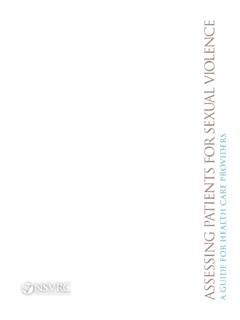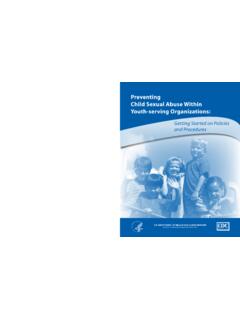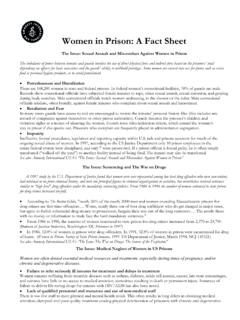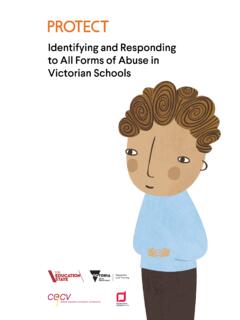Transcription of Long-Term Consequences of Child Abuse and Neglect
1 Child welfare Information GatewayChildren s Bureau/ACYF/ACF/HHS1250 Maryland Avenue, SWEighth FloorWashington, DC : Consequences of Child Abuse and Neglect FACTSHEETJuly 2013 Use your smartphone to access this factsheet en espa s Inside: Factors affecting the Consequences of Child Abuse and Neglect Physical health Consequences Psychological Consequences Behavioral Consequences Societal Consequences Resources References For fiscal year (FY) 2011, States reported that 676,569 children were victims of Child Abuse or Neglect ( Department of health and Human Services, 2012). While physical injuries may or may not be immediately visible, Abuse and Neglect can have Consequences for children, families, and society that last lifetimes, if not Consequences of Child Abuse and material may be freely reproduced and distributed. However, when doing so, please credit Child welfare Information Gateway. Available online at impact of Child Abuse and Neglect is often discussed in terms of physical, psychological, behavioral, and societal Consequences .
2 In reality, however, it is impossible to separate the types of impacts. Physical Consequences , such as damage to a Child s growing brain, can have psychological implications, such as cognitive delays or emotional difficulties. Psychological problems often manifest as high-risk behaviors. Depression and anxiety, for example, may make a person more likely to smoke, Abuse alcohol or drugs, or overeat. High-risk behaviors, in turn, can lead to Long-Term physical health problems, such as sexually transmitted diseases, cancer, and obesity. Not all children who have been abused or neglected will experience long -The Federal Government has made a considerable investment in research on the causes and Long-Term Consequences of Child Abuse and Neglect . These efforts are ongoing; for more information, visit the websites listed below:Adverse Childhood Experiences (ACE) Study is a collaboration between the Centers for Disease Control and Prevention (CDC) and Kaiser Permanente s health Appraisal Clinic in San Diego, CA.
3 It is the largest ongoing examination of the correlation between childhood maltreatment and adult health and well-being outcomes. Data are collected from more than 17,000 participants undergoing regular health screenings who provide information about childhood experiences of Abuse and Neglect . Findings show that certain experiences are risk factors or causes for various illnesses and poor health . (Longitudinal Studies of Child Abuse and Neglect ) is a consortium of longitudinal research studies on the causes and impact of Child Abuse and Neglect . It was initiated in 1990 with grants from the National Center on Child Abuse and Neglect . The size and diversity of the sample (1,354 children from five distinct geographical areas) enables LONGSCAN researchers to examine the relative impact of various forms of maltreatment, alone and in combination. LONGSCAN studies also evaluate the effectiveness of Child protection and Child welfare services. (The National Survey of Child and Adolescent Well-Being) is a project of the Administration on Children, Youth and Families to describe the Child welfare system and the experiences of children and families who come in contact with the system.
4 Survey data are collected from firsthand reports of children, parents, and other caregivers, as well as reports from caseworkers, teachers, and administrative records. NSCAW will continue to follow the life course of these children to gather data about services received during subsequent periods, measures of Child well-being, and longer term results for the study population. This information will provide a clearer understanding of life outcomes for children and families involved with Child welfare . Long-Term Consequences of Child Abuse and Neglect3 This material may be freely reproduced and distributed. However, when doing so, please credit Child welfare Information Gateway. Available online at Consequences , but they may have an increased factsheet explains the Long-Term physical, psychological, behavioral, and societal Consequences of Child Abuse and Neglect . For more information on Abuse and Neglect , including definitions, the different types, and the signs and symptoms, read Child welfare Information Gateway s What Is Child Abuse and Neglect ?
5 Recognizing the Signs and Symptoms: Factors Affecting the Consequences of Child Abuse and NeglectIndividual outcomes vary widely and are affected by a combination of factors, including: The Child s age and developmental status when the Abuse or Neglect occurred The type of maltreatment (physical Abuse , Neglect , sexual Abuse , etc.) The frequency, duration, and severity of the maltreatment The relationship between the Child and the perpetrator Researchers also have begun to explore why, given similar conditions, some children experience Long-Term Consequences of Abuse and Neglect while others emerge relatively unscathed. The ability to cope, and even thrive, following a negative experience is often referred to as resilience. It is important to note that resilience is not an inherent trait in children but results from a mixture of both risk and protective factors that cause a Child s positive or negative reaction to adverse experiences. A number of protective and promotive factors individually, within a family, or within a community may contribute to an abused or neglected Child s resilience.
6 These include positive attachment, self-esteem, intelligence, emotion regulation, humor, and independence (Shaffer, 2012). Physical health ConsequencesThe immediate physical effects of Abuse or Neglect can be relatively minor (bruises or cuts) or severe (broken bones, hemorrhage, or even death). In some cases, the physical effects are temporary; however, the pain and suffering they cause a Child should not be discounted. Child Abuse and Neglect can have a multitude of Long-Term effects on physical health . NSCAW researchers found that, at some point during the 3 years following a maltreatment investigation, 28 percent of children had a chronic health condition (Administration for Children and Families, Office of Planning, Research and Evaluation [ACF/OPRE], 2007). Below are some outcomes other researchers have identified:Abusive head trauma. Abusive head trauma, an inflicted injury to the head and its contents caused by shaking and blunt impact, is the most common cause of traumatic death for infants.
7 The injuries Long-Term Consequences of Child Abuse and material may be freely reproduced and distributed. However, when doing so, please credit Child welfare Information Gateway. Available online at not be immediately noticeable and may include bleeding in the eye or brain and damage to the spinal cord and neck. Significant brain development takes place during infancy, and this important development is compromised in maltreated children. One in every four victims of shaken baby syndrome dies, and nearly all victims experience serious health Consequences (CDC, ). Impaired brain development. Child Abuse and Neglect have been shown to cause important regions of the brain to fail to form or grow properly, resulting in impaired development. These alterations in brain maturation have Long-Term Consequences for cognitive, language, and academic abilities and are connected with mental health disorders (Tarullo, 2012). Disrupted neurodevelopment as a result of maltreatment can cause children to adopt a persistent fear state as well as attributes that are normally helpful during threatening moments but counterproductive in the absence of threats, such as hypervigilance, anxiety, and behavior impulsivity (Perry, 2012).
8 Child welfare Information Gateway has produced two publications on the impact of maltreatment on brain development. Supporting Brain Development in Traumatized Children and Youth: Understanding the Effects of Maltreatment on Brain Development: physical health . Several studies have shown a relationship between various forms of Child maltreatment and poor health . Adults who experienced Abuse or Neglect during childhood are more likely to suffer from cardiovascular disease, lung and liver disease, hypertension, diabetes, asthma, and obesity (Felitti & Anda, 2009). Specific physical health conditions are also connected to maltreatment type. One study showed that children who experienced Neglect were at increased risk for diabetes and poorer lung functioning, while physical Abuse was shown to increase the risk for diabetes and malnutrition (Widom, Czaja, Bentley, & Johnson, 2012). Additionally, Child maltreatment has been shown to increase adolescent obesity.
9 A longitudinal study found that children who experienced Neglect had body mass indexes that grew at significantly faster rates compared to children who had not experienced Neglect (Shin & Miller, 2012). Psychological ConsequencesThe immediate emotional effects of Abuse and Neglect isolation, fear, and an inability to trust can translate into lifelong psychological Consequences , including low self-esteem, depression, and relationship difficulties. Researchers have identified links between Child Abuse and Neglect and the following:Difficulties during infancy. Of children entering foster care in 2010, 16 percent were younger than 1 year. When infants and young children enter out-of-home care due to Abuse or Neglect , the trauma of a primary caregiver change negatively affects their attachments (ACF/OPRE, 2012a). Nearly Long-Term Consequences of Child Abuse and Neglect5 This material may be freely reproduced and distributed. However, when doing so, please credit Child welfare Information Gateway.
10 Available online at of infants in foster care who have experienced maltreatment exhibit some form of cognitive delay and have lower IQ scores, language difficulties, and neonatal challenges compared to children who have not been abused or neglected (ZERO TO THREE, 2011). Poor mental and emotional health . Experiencing childhood trauma and adversity, such as physical or sexual Abuse , is a risk factor for borderline personality disorder, depression, anxiety, and other psychiatric disorders. One study using ACE data found that roughly 54 percent of cases of depression and 58 percent of suicide attempts in women were connected to adverse childhood experiences (Felitti & Anda, 2009). Child maltreatment also negatively impacts the development of emotion regulation, which often persists into adolescence or adulthood (Messman-Morre, Walsh, & DiLillo, 2010). Cognitive difficulties. NSCAW researchers found that children with substantiated reports of maltreatment were at risk for severe developmental and cognitive problems, including grade repetition (ACF/OPRE, 2012b).














